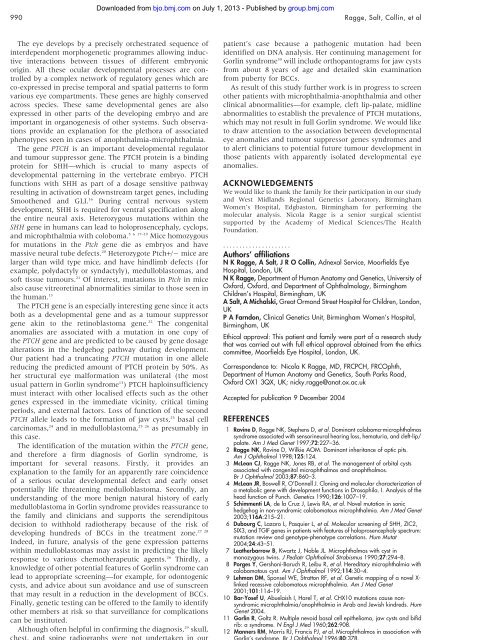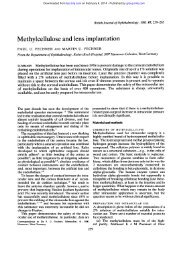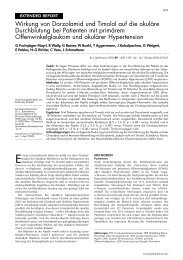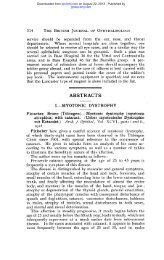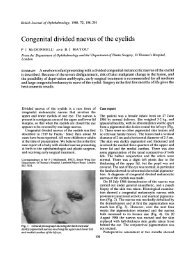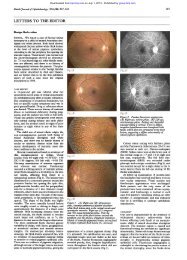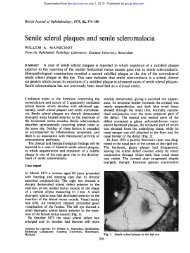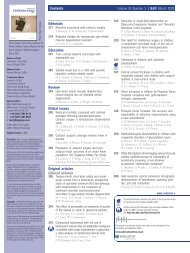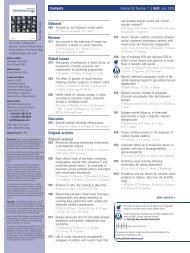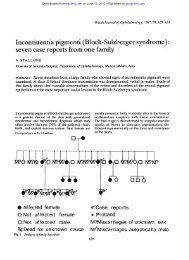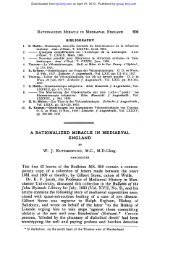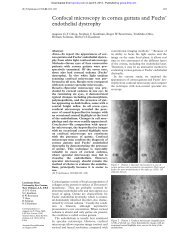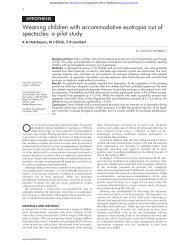Gorlin syndrome: the PTCH gene links ocular developmental defects ...
Gorlin syndrome: the PTCH gene links ocular developmental defects ...
Gorlin syndrome: the PTCH gene links ocular developmental defects ...
Create successful ePaper yourself
Turn your PDF publications into a flip-book with our unique Google optimized e-Paper software.
Downloaded from<br />
bjo.bmj.com on July 1, 2013 - Published by group.bmj.com<br />
990 Ragge, Salt, Collin, et al<br />
The eye develops by a precisely orchestrated sequence of<br />
interdependent morpho<strong>gene</strong>tic programmes allowing inductive<br />
interactions between tissues of different embryonic<br />
origin. All <strong>the</strong>se <strong>ocular</strong> <strong>developmental</strong> processes are controlled<br />
by a complex network of regulatory <strong>gene</strong>s which are<br />
co-expressed in precise temporal and spatial patterns to form<br />
various eye compartments. These <strong>gene</strong>s are highly conserved<br />
across species. These same <strong>developmental</strong> <strong>gene</strong>s are also<br />
expressed in o<strong>the</strong>r parts of <strong>the</strong> developing embryo and are<br />
important in organo<strong>gene</strong>sis of o<strong>the</strong>r systems. Such observations<br />
provide an explanation for <strong>the</strong> plethora of associated<br />
phenotypes seen in cases of anophthalmia-microphthalmia.<br />
The <strong>gene</strong> <strong>PTCH</strong> is an important <strong>developmental</strong> regulator<br />
and tumour suppressor <strong>gene</strong>. The <strong>PTCH</strong> protein is a binding<br />
protein for SHH—which is crucial to many aspects of<br />
<strong>developmental</strong> patterning in <strong>the</strong> vertebrate embryo. <strong>PTCH</strong><br />
functions with SHH as part of a dosage sensitive pathway<br />
resulting in activation of downstream target <strong>gene</strong>s, including<br />
Smoo<strong>the</strong>ned and GLI. 16 During central nervous system<br />
development, SHH is required for ventral specification along<br />
<strong>the</strong> entire neural axis. Heterozygous mutations within <strong>the</strong><br />
SHH <strong>gene</strong> in humans can lead to holoprosencephaly, cyclops,<br />
and microphthalmia with coloboma. 5 6 17–19 Mice homozygous<br />
for mutations in <strong>the</strong> Ptch <strong>gene</strong> die as embryos and have<br />
massive neural tube <strong>defects</strong>. 20 Heterozygote Ptch+/2 mice are<br />
larger than wild type mice, and have hindlimb <strong>defects</strong> (for<br />
example, polydactyly or syndactyly), medulloblastomas, and<br />
soft tissue tumours. 21 Of interest, mutations in Ptch in mice<br />
also cause vitreoretinal abnormalities similar to those seen in<br />
<strong>the</strong> human. 13<br />
The <strong>PTCH</strong> <strong>gene</strong> is an especially interesting <strong>gene</strong> since it acts<br />
both as a <strong>developmental</strong> <strong>gene</strong> and as a tumour suppressor<br />
<strong>gene</strong> akin to <strong>the</strong> retinoblastoma <strong>gene</strong>. 22 The congenital<br />
anomalies are associated with a mutation in one copy of<br />
<strong>the</strong> <strong>PTCH</strong> <strong>gene</strong> and are predicted to be caused by <strong>gene</strong> dosage<br />
alterations in <strong>the</strong> hedgehog pathway during development.<br />
Our patient had a truncating <strong>PTCH</strong> mutation in one allele<br />
reducing <strong>the</strong> predicted amount of <strong>PTCH</strong> protein by 50%. As<br />
her structural eye malformation was unilateral (<strong>the</strong> most<br />
usual pattern in <strong>Gorlin</strong> <strong>syndrome</strong> 13 ) <strong>PTCH</strong> haploinsufficiency<br />
must interact with o<strong>the</strong>r localised effects such as <strong>the</strong> o<strong>the</strong>r<br />
<strong>gene</strong>s expressed in <strong>the</strong> immediate vicinity, critical timing<br />
periods, and external factors. Loss of function of <strong>the</strong> second<br />
<strong>PTCH</strong> allele leads to <strong>the</strong> formation of jaw cysts, 23 basal cell<br />
carcinomas, 24 and in medulloblastoma, 25 26 as presumably in<br />
this case.<br />
The identification of <strong>the</strong> mutation within <strong>the</strong> <strong>PTCH</strong> <strong>gene</strong>,<br />
and <strong>the</strong>refore a firm diagnosis of <strong>Gorlin</strong> <strong>syndrome</strong>, is<br />
important for several reasons. Firstly, it provides an<br />
explanation to <strong>the</strong> family for an apparently rare coincidence<br />
of a serious <strong>ocular</strong> <strong>developmental</strong> defect and early onset<br />
potentially life threatening medulloblastoma. Secondly, an<br />
understanding of <strong>the</strong> more benign natural history of early<br />
medulloblastoma in <strong>Gorlin</strong> <strong>syndrome</strong> provides reassurance to<br />
<strong>the</strong> family and clinicians and supports <strong>the</strong> serendipitous<br />
decision to withhold radio<strong>the</strong>rapy because of <strong>the</strong> risk of<br />
27 28<br />
developing hundreds of BCCs in <strong>the</strong> treatment zone.<br />
Indeed, in future, analysis of <strong>the</strong> <strong>gene</strong> expression patterns<br />
within medulloblastomas may assist in predicting <strong>the</strong> likely<br />
response to various chemo<strong>the</strong>rapeutic agents. 26 Thirdly, a<br />
knowledge of o<strong>the</strong>r potential features of <strong>Gorlin</strong> <strong>syndrome</strong> can<br />
lead to appropriate screening—for example, for odontogenic<br />
cysts, and advice about sun avoidance and use of sunscreen<br />
that may result in a reduction in <strong>the</strong> development of BCCs.<br />
Finally, <strong>gene</strong>tic testing can be offered to <strong>the</strong> family to identify<br />
o<strong>the</strong>r members at risk so that surveillance for complications<br />
can be instituted.<br />
Although often helpful in confirming <strong>the</strong> diagnosis, 29 skull,<br />
chest, and spine radiographs were not undertaken in our<br />
www.bjophthalmol.com<br />
patient’s case because a pathogenic mutation had been<br />
identified on DNA analysis. Her continuing management for<br />
<strong>Gorlin</strong> <strong>syndrome</strong> 30 will include orthopantograms for jaw cysts<br />
from about 8 years of age and detailed skin examination<br />
from puberty for BCCs.<br />
As result of this study fur<strong>the</strong>r work is in progress to screen<br />
o<strong>the</strong>r patients with microphthalmia-anophthalmia and o<strong>the</strong>r<br />
clinical abnormalities—for example, cleft lip-palate, midline<br />
abnormalities to establish <strong>the</strong> prevalence of <strong>PTCH</strong> mutations,<br />
which may not result in full <strong>Gorlin</strong> <strong>syndrome</strong>. We would like<br />
to draw attention to <strong>the</strong> association between <strong>developmental</strong><br />
eye anomalies and tumour suppressor <strong>gene</strong>s <strong>syndrome</strong>s and<br />
to alert clinicians to potential future tumour development in<br />
those patients with apparently isolated <strong>developmental</strong> eye<br />
anomalies.<br />
ACKNOWLEDGEMENTS<br />
We would like to thank <strong>the</strong> family for <strong>the</strong>ir participation in our study<br />
and West Midlands Regional Genetics Laboratory, Birmingham<br />
Women’s Hospital, Edgbaston, Birmingham for performing <strong>the</strong><br />
molecular analysis. Nicola Ragge is a senior surgical scientist<br />
supported by <strong>the</strong> Academy of Medical Sciences/The Health<br />
Foundation.<br />
.....................<br />
Authors’ affiliations<br />
N K Ragge, A Salt, J R O Collin, Adnexal Service, Moorfields Eye<br />
Hospital, London, UK<br />
N K Ragge, Department of Human Anatomy and Genetics, University of<br />
Oxford, Oxford, and Department of Ophthalmology, Birmingham<br />
Children’s Hospital, Birmingham, UK<br />
A Salt, A Michalski, Great Ormond Street Hospital for Children, London,<br />
UK<br />
P A Farndon, Clinical Genetics Unit, Birmingham Women’s Hospital,<br />
Birmingham, UK<br />
Ethical approval: This patient and family were part of a research study<br />
that was carried out with full ethical approval obtained from <strong>the</strong> ethics<br />
committee, Moorfields Eye Hospital, London, UK.<br />
Correspondence to: Nicola K Ragge, MD, FRCPCH, FRCOphth,<br />
Department of Human Anatomy and Genetics, South Parks Road,<br />
Oxford OX1 3QX, UK; nicky.ragge@anat.ox.ac.uk<br />
Accepted for publication 9 December 2004<br />
REFERENCES<br />
1 Ravine D, Ragge NK, Stephens D, et al. Dominant coloboma-microphthalmos<br />
<strong>syndrome</strong> associated with sensorineural hearing loss, hematuria, and cleft-lip/<br />
palate. Am J Med Genet 1997;72:227–36.<br />
2 Ragge NK, Ravine D, Wilkie AOM. Dominant inheritance of optic pits.<br />
Am J Ophthalmol 1998;125:124.<br />
3 McLean CJ, Ragge NK, Jones RB, et al. The management of orbital cysts<br />
associated with congenital microphthalmos and anophthalmos.<br />
Br J Ophthalmol 2003;87:860–3.<br />
4 McLean JR, Boswell R, O’Donnell J. Cloning and molecular characterization of<br />
a metabolic <strong>gene</strong> with development functions in Drosophila. I. Analysis of <strong>the</strong><br />
head function of Punch. Genetics 1990;126:1007–19.<br />
5 Schimmenti LA, de la Cruz J, Lewis RA, et al. Novel mutation in sonic<br />
hedgehog in non-syndromic colobomatous microphthalmia. Am J Med Genet<br />
2003;116A:215–21.<br />
6 Dubourg C, Lazaro L, Pasquier L, et al. Molecular screening of SHH, ZIC2,<br />
SIX3, and TGIF <strong>gene</strong>s in patients with features of holoprosencephaly spectrum:<br />
mutation review and genotype-phenotype correlations. Hum Mutat<br />
2004;24:43–51.<br />
7 Lea<strong>the</strong>rbarrow B, Kwartz J, Noble JL. Microphthalmos with cyst in<br />
monozygous twins. J Pediatr Ophthalmol Strabismus 1990;27:294–8.<br />
8 Porges Y, Gershoni-Baruch R, Leibu R, et al. Hereditary microphthalmia with<br />
colobomatous cyst. Am J Ophthalmol 1992;114:30–4.<br />
9 Lehman DM, Sponsel WE, Stratton RF, et al. Genetic mapping of a novel Xlinked<br />
recessive colobomatous microphthalmia. Am J Med Genet<br />
2001;101:114–19.<br />
10 Bar-Yosef U, Abuelaish I, Harel T, et al. CHX10 mutations cause nonsyndromic<br />
microphthalmia/anophthalmia in Arab and Jewish kindreds. Hum<br />
Genet 2004.<br />
11 <strong>Gorlin</strong> R, Goltz R. Multiple nevoid basal cell epi<strong>the</strong>lioma, jaw cysts and bifid<br />
rib: a <strong>syndrome</strong>. N Engl J Med 1960;262:908.<br />
12 Manners RM, Morris RJ, Francis PJ, et al. Microphthalmos in association with<br />
<strong>Gorlin</strong>’s <strong>syndrome</strong>. Br J Ophthalmol 1996;80:378.


